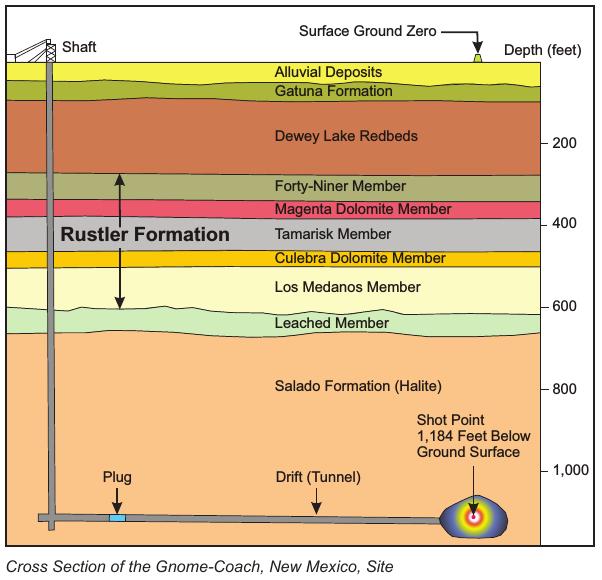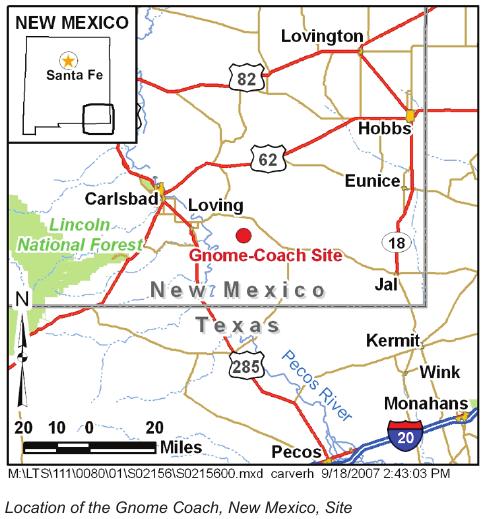The EEOICPA was passed in 2000. It provides compensation to workers who became ill as a result of their employment manufacturing nuclear weapons in the USA, as well as their spouses, children, and grandchildren. Project Gnome Nuclear Explosion Site EEOICPA coverage is available for qualified former Workers and their families.
Are you eligible for compensation? If you or a family member worked at this or another DOE facility and became ill, you may be entitled to compensation of up to $400K plus medical benefits. Call EEOICPA Counsel Hugh Stephens at 1-855-548-4494 or fill out our free claim evaluation, We can help even if you’ve already filed, even if your claim was denied!
Here, we have compiled publicly available information and documentation about the facilities covered by the Act to clarify how their activities relate to the Energy Employees Occupational Illness Compensation Program Act.
Project Gnome Nuclear Explosion Site
Also Known As: Gnome
State: New Mexico
Location: Carlsbad
Time Period: 1960-1962
Facility Type: Department of Energy
Facility Description: The Project Gnome Test site was the location of one of the nuclear test explosions conducted as part of the part of the AEC’s Plowshare program, which was initiated in 1957 to develop peaceful (industrial and scientific) applications for nuclear explosives. Shaft excavation began July 1, 1960. In December 10, 1961, Shot Gnome, a 3kiloton yield nuclear device, was detonated in an underground shaft to identify the effects and products of an underground nuclear explosion in a salt medium. The shot vented some radioactivity into the atmosphere. Reentry activities were completed in June 1962.
Listing:
Project Gnome Nuclear Explosion Site Explosion Site is listed as a Department of Energy (DOE) site under the EEOICPA.
Compensation:
As of 05/10/2015, the total compensation paid under Parts B and E of the EEOICPA, including medical compensation, for workers suffering from the effects of having worked at the Project Gnome Nuclear Explosion Site Explosion Site is $3,028,369.
*Site Description and History :
The Gnome-Coach site encompasses approximately 680 acres in southern Eddy County, New Mexico, about 9 miles east of the Pecos River and 25 miles southeast of the city of Carlsbad. The land is currently withdrawn from all forms of appropriation associated with mining and leasing laws.
On December 10, 1961, a 3-kiloton-yield nuclear explosive was detonated at a depth of 1,184 feet below ground surface within the Salado Formation, a thick, bedded salt deposit. Project Gnome was the first nuclear test conducted in the Plowshare Program, a research and development program created by the U.S. Atomic Energy Commission (AEC), a predecessor agency to the U.S. Department of Energy (DOE). The purpose of the program was to determine the technical and economic feasibility of peaceful applications of nuclear explosives.
The Gnome test was a multipurpose experiment designed to provide data concerning heat generated from a nuclear explosion, isotope production, neutron physics, seismic measurements in a salt medium, and to provide design data for developing nuclear devices specifically for peaceful uses. In preparation for the Gnome test, a 10-foot-diameter vertical emplacement shaft was drilled to a depth of 1,216 feet below ground surface. A horizontal tunnel was drilled 1,116 feet northeast from the shaft, ending in a hook shape designed to be self-sealing.
The Gnome detonation created a cavity approximately 160 feet in diameter and melted about 3,150 tons of rock. The melted rock mixed with approximately 11,415 tons of salt that was propelled into the cavity by steam pressure produced from water in the rock. Most of the nongaseous radioactive residue was trapped in the mixture of rubble and once-molten salt at the bottom of the chamber. Although it had been planned as a contained explosion, a portion of the gases produced by the Gnome detonation vented radioactive materials into the atmosphere through the vertical emplacement shaft southwest of the cavity. A second test, Coach, was to be located within the Salado Formation near the Gnome test location and was scheduled for 1963. The Coach test was canceled, but the site is referred to as the Gnome-Coach site. No additional underground nuclear detonations occurred at the Gnome-Coach site; however, in 1963, the U.S. Geological Survey (USGS) conducted a groundwater tracer test using four dissolved radionuclides–tritium, iodine-131, strontium-90, and cesium 137– as tracers. These isotopes were injected into groundwater of the Culebra Dolomite Member of the Rustler Formation. The Culebra is about 30 feet thick in the site area; the base of the Culebra is about 490 feet below land surface and about 690 feet above the detonation cavity. Post-test activities included drilling into the test cavity from locations directly over the cavity as well as reentry through the shaft and horizontal tunnel following removal of rubble and solidified melt. Five months after the blast, personnel physically entered the test cavity through the tunnel to directly observe the cavity interior and obtain photographic documentation of the cavity size and shape.
Surface Conditions:
Post-test drilling and removal of contaminated subsurface material resulted in surface contamination at the Gnome-Coach site. The original cleanup associated with the site was conducted between 1968 and 1969. During this phase, radioactive sludge from holding tanks Cross Seand liquid from evaporation ponds were pumped into the test cavity, contaminated equipment and solid waste were disposed of in the emplacement shaft, all salvageable equipment was decontaminated, all uncontaminated buildings and equipment were moved offsite, and all AEC test wells and drill holes were plugged and abandoned (except those retained for long-term hydrologic monitoring).
In 1972, an area reconnaissance revealed that the cover material on the salt disposal pile that remained from drilling operations was eroding, exposing material contaminated from the reentry operations, and surface contamination associated with the salt disposal pile was spreading. The second major cleanup from 1977 to 1979 included excavating contaminated soils and burying them in the shaft, removing concrete pads, performing general housekeeping activities, and conducting extensive post-cleanup sampling. During these operations, the test cavity and horizontal tunnel were filled to capacity, and remaining contaminated material was removed and transported to the Nevada National Security Site (then known as the Nevada Test Site).
In 2002, the DOE Office of Environmental Management completed a corrective action investigation of the Gnome-Coach site surface area. These studies included sampling and surveying surface and shallow subsurface soils to a depth of 20 feet below ground surface. Although elevated levels of radiological contamination were identified in several areas, the concentrations did not exceed risk-based cleanup levels. Approximately 18 cubic yards of soil contaminated with diesel fuel at levels that exceeded the New Mexico Environment Department cleanup standard were removed during supplemental field activities in 2003. Investigation activities and a summary of the results are documented in a Completion Report that was prepared in accordance with the New Mexico Environment Department Voluntary Remediation Program.
A permanent monument consisting of two brass plaques mounted in a concrete base was placed directly above the underground nuclear detonation cavity. Wording on one plaque describes the historical significance of the project, and wording on the second plaque describes restrictions on excavation and drilling in the area.
Subsurface Conditions:
DOE conducts annual monitoring of the subsurface by collecting groundwater samples and monitoring water levels in the five monitoring wells onsite. The groundwater samples are analyzed for the detonation-related and tracer-test-related contaminants tritium, cesium-137, and strontium-90. The wells onsite monitor the detonation-related radionuclides and shaft in the Salado Formation and groundwater in the Culebra Dolomite Member of the Rustler Formation, which was the zone in which USGS conducted the tracer test. The Salado Formation is a 2,500-foot-thick bed of halite that is virtually impermeable due to the plastic nature under pressure. The Culebra Dolomite is a widespread, laterally continuous, fractured carbonate aquifer. Although groundwater within the Culebra is of poor quality because of high concentrations of dissolved solids, it is a source of water for ranchers who maintain livestock throughout the area. DOE continues to conduct investigations to obtain data that will enhance the monitoring of the subsurface.
Long-Term Hydrologic Monitoring Program:
The U.S. Environmental Protection Agency monitored groundwater quality at and near the Gnome-Coach site annually from 1972 until 2008 as part of its Long-Term Hydrologic Monitoring Program. Samples were historically collected from 10 wells and 2 municipal water supplies offsite. Since the program’s inception, analytical results using conventional analytical methods have detected no radionuclides related to the underground nuclear test or tracer test in any of the samples collected from the offsite locations. In 2009, DOE’s Office of Legacy Management (LM) assumed responsibility for groundwater monitoring at the site. After reviewing historical data, LM refined the monitoring network for the site, and current efforts focus on monitoring the onsite wells.
Land Use:
The designated surface use of the Gnome-Coach site is for grazing. Principal land use in the area is livestock grazing, oil and gas exploration and production, and recreation. Although active oil and gas leases exist for the land surrounding the Gnome-Coach site, oil and gas leases are not permitted on the site.
Institutional Controls:
The Gnome-Coach site and surrounding land were withdrawn from the public domain on October 26, 1961. All of Section 34 and part of Section 10, Township 23 South, Range 30 East, New Mexico Principal Meridian were transferred from the U.S. Department of the Interior Bureau of Land Management (BLM) to AEC for the Gnome and Coach experiments. BLM maintains the surface rights of the withdrawn lands. Restrictions for the ground surface (0 to 20 feet below ground surface) are documented in the Conditional Certificate of Completion provided by the New Mexico Environment Department in accordance with their Voluntary Remediation Program regulations. The surface restrictions include no excavation within 40 lateral feet of the concrete cap that protects the emplacement shaft. Current subsurface restrictions are stated on the monument placed at the site. As an added layer of protection, LM is working with BLM to include restrictions for the subsurface of Section 34 in BLM’s Resource Management Plan. The former shaft, horizontal tunnel, and Project Gnome monument are all located within Section 34.
Project Gnome Nuclear Explosion Site Explosion Site Workers:
If you or your parent worked at this or any other DOE or AWE facility and became ill, you may be entitled to compensation of up to $400K plus medical benefits from the US Department of Labor. Call EEOICPA Counsel Hugh Stephens at 1-855-EEOICPA (336-4272) or fill out the form to the right, whether or not you have already filed a claim and even if your claim has been accepted or denied.
We can help with all OWCP (Federal Workers Compensation) claims, impairments, wage loss and health care. 2495 Main Street, Suite 442, Buffalo, NY 14214.



















